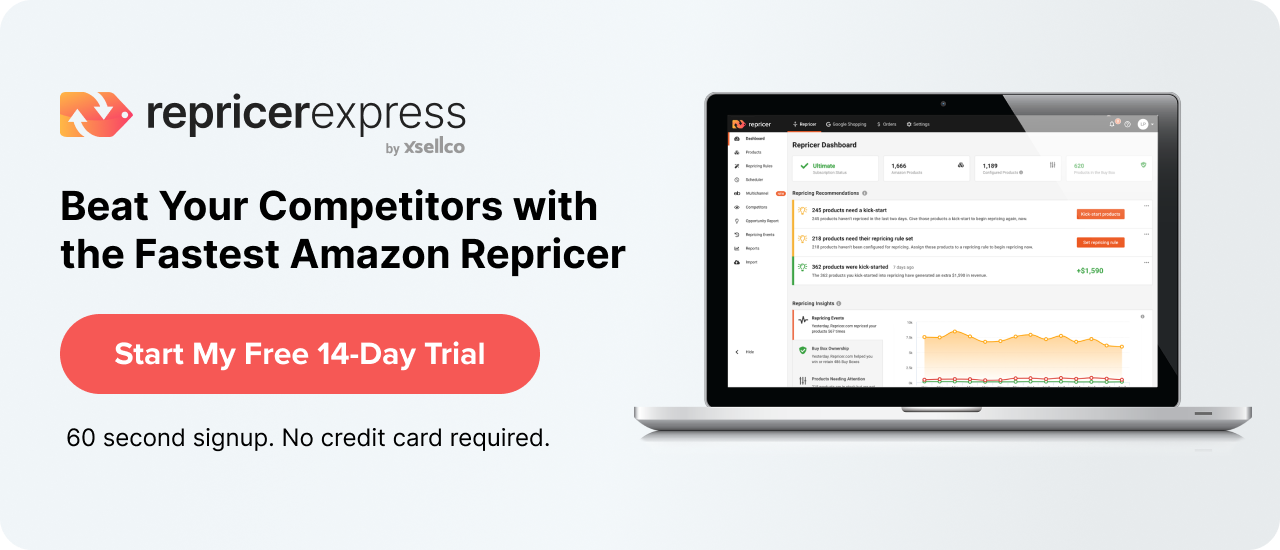Pricing your products is both a science and an art, as the balance between profit and customer base is a tricky one to achieve. And when you factor in the Buy Box as the reward for mastering the science and art of it, RepricerExpress knows that when to price higher or lower is never more important.
The Necessities of Altering Your Prices
It’d be a somewhat magical thing if you could just slap a price onto each individual product and call it a day — forever. If you never had to bother with altering your prices, then you’d never have to worry about if that’s what’s holding you back from securing a greater customer base. Instead, you could forget about that part and just focus on the other elements of growing your business.
Unfortunately, that’s not how it works in ecommerce (or any kind of commerce, for that matter). Prices fluctuate constantly, and according to market and consumer demand. Your Slinkies could be a couple of bucks today and just mere pennies tomorrow, depending on what your buyers and competitors are doing.
It takes practice to get the balance point right, so go easy on yourself at first. You’ll want to spend time on your not-as-profitable items to master the art and science of when to price higher or lower as opposed to tinkering with your more-profitable items and potentially losing out on more profit.
But how do you know when to apply which tactic?
You’ll Want to Price Higher When…
- You’re interested in maximising your profit margin.
- You stay within the top 10 lowest prices.
- You’re a veteran seller who’s not afraid to stick to your own plan.
- Your pricing plan involves more than just a single item.
- You want to lure buyers in with the air of exclusivity and quality (think Starbucks coffee versus the cheap sludge at your corner shop).
- The item is ranked highly within its category and there are three or more of it to sell.
- You’re looking to redirect revenue into your inventory to keep growing your business.
- You don’t have a lot of direct competition.
These shouldn’t be hard and fast rules for raising your prices, but rather general guidelines that could rake in more revenue and, potentially, profit. Over time, you’ll develop a feel for when you want to hike prices a bit and the conditions that warrant such a move.
On the other hand —
You’ll Want to Price Lower When…
- You have leftover or slow-moving items you want to clear quickly.
- Products are taking up valuable space in your area of the Amazon warehouse and you risk getting dinged for long-term storage fees.
- You’re trying to clear out seasonal stock so it doesn’t become stale or passé.
- You’re competing with Amazon directly and it’s possible to out-sell them.
- The product is doing well within its category and you can turn over a quick and tidy profit.
- You need to boost business activity by attracting new customers.
- Price is the last thing standing between you and the Buy Box.
- You’re facing a lot of direct competition.
Raising prices is one thing, as your buyers will quickly tell you if they approve or not. And if they don’t, then it’s a fairly simple fix to right the ship.
But lowering them, on the other hand, is a much riskier venture. It opens up the possibility of a race to the bottom where nobody wins, and can severely cut into your profit margin and future business viability.
Be careful with this strategy.
Final Thoughts
One of the niftiest ways you can know when to price higher or lower is to use repricing software, like RepricerExpress! Not that we’re tooting our own horn, but it really makes life easier when you don’t have to fiddle with individual prices all the time and can just let something else do the work for you. But to get to the easy life, you have to sign up for your free 15-day trial first.
Related: How to Avoid a Price War on Amazon






